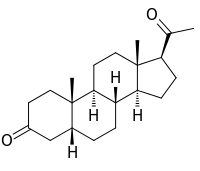5β-Dihydroprogesterone
5β-Dihydroprogesterone (5β-DHP, pregnanedione, or 5β-pregnane-3,20-dione) is an endogenous neurosteroid and an intermediate in the biosynthesis of pregnanolone and epipregnanolone from progesterone.[1][2][3] It is synthesized from progesterone by the enzyme 5β-reductase.[1][4]
 | |
| Names | |
|---|---|
| IUPAC name
Pregnanedione; 5β-Pregnane-3,20-dione | |
| Identifiers | |
3D model (JSmol) |
|
| ChemSpider | |
PubChem CID |
|
| UNII | |
CompTox Dashboard (EPA) |
|
| |
| Properties | |
| C21H32O2 | |
| Molar mass | 316.485 g·mol−1 |
Except where otherwise noted, data are given for materials in their standard state (at 25 °C [77 °F], 100 kPa). | |
| Infobox references | |
5β-DHP has been found to act as a positive allosteric modulator of the GABAA receptor (albeit with an affinity for this receptor regarded as relatively low in comparison to 3α-hydroxylated progesterone metabolites such as pregnanolone and allopregnanolone)[5] and also as a negative allosteric modulator of the GABAA-rho receptor.[6] In accordance with the former action, it has been found to possess anesthetic, anxiolytic, and antinociceptive effects.[7][5][8][9] 5β-DHP has been found to act as an agonist of the pregnane X receptor (PXR) as well (albeit weakly (EC50 >10,000 μM)),[10] and has been found to regulate uterine contractility through activation of this receptor.[11][12] Unlike 5α-dihydroprogesterone, 5β-DHP possesses only very weak affinity for the progesterone receptor (1.2% of that of progesterone in rhesus monkey uterus), and hence, is not a progestogen.[13][14]
A study found that 5β-DHP, but not progesterone, directly bound to and antagonized the oxytocin receptor at nanomolar concentrations, and it was suggested that this may be one of the mechanisms by which progesterone maintains pregnancy.[15][16][17] However, a subsequent study was unable to replicate this finding, and there has been no further investigation since.[16] In any case, 5β-DHP has nonetheless been shown to possess tocolytic effects in animals, and this may alternatively be mediated by activation of the PXR.[12]
References
- Neurosteroids and Brain Function. Academic Press. 12 December 2001. pp. 464–. ISBN 978-0-08-054423-6.
- Neurosteroids. Frontiers E-books. pp. 8–. ISBN 978-2-88919-078-2.
- Gilbert Evans, Susan E.; Ross, Lori E.; Sellers, Edward M.; Purdy, Robert H.; Romach, Myroslava K. (2005). "3α-reduced neuroactive steroids and their precursors during pregnancy and the postpartum period". Gynecological Endocrinology. 21 (5): 268–279. doi:10.1080/09513590500361747. ISSN 0951-3590. PMID 16373246.
- Sheehan PM, Rice GE, Moses EK, Brennecke SP (2005). "5 Beta-dihydroprogesterone and steroid 5 beta-reductase decrease in association with human parturition at term". Mol. Hum. Reprod. 11 (7): 495–501. doi:10.1093/molehr/gah201. PMID 16123077.
- Ocvirk, Rok; Pearson Murphy, Beverley E.; Franklin, Keith B.J.; Abbott, Frances V. (2008). "Antinociceptive profile of ring A-reduced progesterone metabolites in the formalin test". Pain. 138 (2): 402–409. doi:10.1016/j.pain.2008.01.019. ISSN 0304-3959. PMID 18343034.
- Morris KD, Moorefield CN, Amin J (1999). "Differential modulation of the gamma-aminobutyric acid type C receptor by neuroactive steroids". Mol. Pharmacol. 56 (4): 752–9. PMID 10496958.
- Selye, H. (1941). "Anesthetic Effect of Steroid Hormones". Experimental Biology and Medicine. 46 (1): 116–121. doi:10.3181/00379727-46-11907. ISSN 1535-3702.
- Leb, Colette R.; Hu, Fen-Yun; Pearson Murphy, Beverley E. (1997). "Metabolism of Progesterone by Human Lymphocytes: Production of Neuroactive Steroids1". The Journal of Clinical Endocrinology & Metabolism. 82 (12): 4064–4068. doi:10.1210/jcem.82.12.4354. ISSN 0021-972X. PMID 9398714.
- Rodgers, R (1998). "Behaviorally Selective Effects of Neuroactive Steroids on Plus-Maze Anxiety in Mice". Pharmacology Biochemistry and Behavior. 59 (1): 221–232. doi:10.1016/S0091-3057(97)00339-0. ISSN 0091-3057.
- Lehmann JM, McKee DD, Watson MA, Willson TM, Moore JT, Kliewer SA (1998). "The human orphan nuclear receptor PXR is activated by compounds that regulate CYP3A4 gene expression and cause drug interactions". J. Clin. Invest. 102 (5): 1016–23. doi:10.1172/JCI3703. PMC 508967. PMID 9727070.
- Hagedorn, K. A.; Cooke, C.-L.; Falck, J. R.; Mitchell, B. F.; Davidge, S. T. (2006). "Regulation of Vascular Tone During Pregnancy: A Novel Role for the Pregnane X Receptor". Hypertension. 49 (2): 328–333. doi:10.1161/01.HYP.0000253478.51950.27. ISSN 0194-911X. PMID 17159084.
- Mitchell, Bryan F.; Mitchell, Jana M.; Chowdhury, Jeeshan; Tougas, Michelle; Engelen, Sanne M.E.; Senff, Nancy; Heijnen, Iris; Moore, John T.; Goodwin, Bryan; Wong, Susan; Davidge, Sandra T. (2005). "Metabolites of progesterone and the pregnane X receptor: A novel pathway regulating uterine contractility in pregnancy?". American Journal of Obstetrics and Gynecology. 192 (4): 1304–1313. doi:10.1016/j.ajog.2005.01.040. ISSN 0002-9378. PMID 15846226.
- Lima-Hernández, Francisco J.; Beyer, Carlos; Gómora-Arrati, Porfirio; García-Juárez, Marcos; Encarnación-Sánchez, José L.; Etgen, Anne M.; González-Flores, Oscar (2012). "Src kinase signaling mediates estrous behavior induced by 5β-reduced progestins, GnRH, prostaglandin E2 and vaginocervical stimulation in estrogen-primed rats". Hormones and Behavior. 62 (5): 579–584. doi:10.1016/j.yhbeh.2012.09.004. ISSN 0018-506X. PMID 23010621.
- Illingworth DV, Elsner C, De Groot K, Flickinger GL, Mikhail G (February 1977). "A specific progesterone receptor of myometrial cytosol from the rhesus monkey". J. Steroid Biochem. 8 (2): 157–60. doi:10.1016/0022-4731(77)90040-1. PMID 405534.
- Alexandros Makriyannis; Diane Biegel (4 November 2003). Drug Discovery Strategies and Methods. CRC Press. pp. 190–. ISBN 978-0-8247-5767-0.
- Creasy, Robert K.; Resnik, Robert; Iams, Jay D.; Lockwood, Charles J.; Greene, Michael F.; Moore, Thomas R. (2013). Creasy and Resnik's Maternal-Fetal Medicine: Principles and Practice. Elsevier Health Sciences. pp. 72–. ISBN 978-1-4557-1137-6.
- Knobil and Neill's Physiology of Reproduction. Academic Press. 12 December 2005. pp. 2952–. ISBN 978-0-08-053527-2.